With the fifth annual Afternoon Tea Week taking place from August 8th-14th, now has never been a better time to experience the theatre of an afternoon tea experience. In London especially, there is so much more to a good cuppa than fine china and cucumber sandwiches. Most excitingly, the way people experience tea in London continues to evolve.
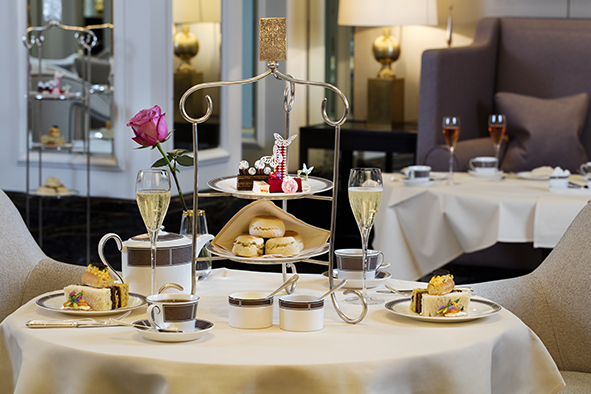
Champagne and cake: The Langham afternoon tea with Wedgwood (Photo: courtesy of The Langham)
“Would you like to start with some champagne, sir?” asks the friendly waiter.
There I am, sipping champagne in The Palm Court inside The Langham Hotel, as an amuse bouche – elderflower gratin with a strawberry topping – is brought over. “This is how all tea times should be,” I tell my friend H.
For a moment the taste alone is enough to distract me from my previous feeling of being out of place here. This is only the third time in my life that I have drunk real champagne; something reserved for major life events. I feel as though I have more in common with the waiters than the clientele.
I look over at H, who is equally taken aback. Part of me balks at the lavishness of it all, but at the same time there is something thrilling about the experience. We can’t stop looking around at the other people, wondering what they do and how this lifestyle seems so easy to them. Although that game can become quite demoralizing in a place like this.
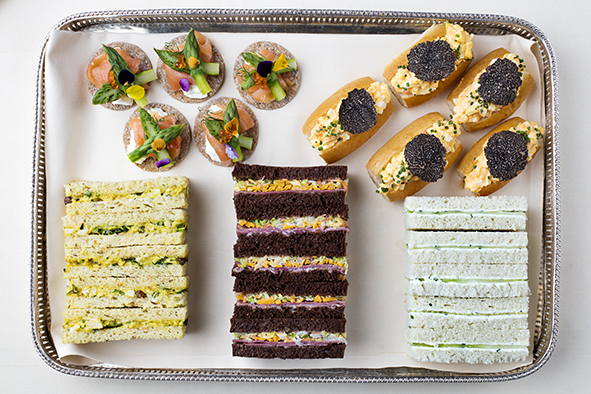
Sandwiches at The Langham afternoon tea with Wedgwood (Photo: courtesy of The Langham)
Much More than Cucumber Sandwiches
Despite massive refurbishment at The Langham in past decades, the hotel’s storied past still shines through in its Victorian architecture. This was where Sherlock Holmes solved a couple of cases in the imagination of Sir Arthur Conan Doyle. This was where the likes of Mark Twain and Oscar Wilde have stayed. And this was where, in 1865, the tradition of afternoon tea was cemented in British culture.
The Langham was the first hotel to offer what had previously been limited to the confines of an elite circle of wealthy ladies, first started by the Duchess of Bedford in the 1840s. It was no longer about looking to outdo one another in an envious flurry of status scrambling, between mid-afternoon blood sugar slumps. It was about taking afternoon tea to a much higher level. For over 150 years-worth of afternoons The Langham has welcomed to afternoon tea those fortunate enough to afford it. But now this experience of living the high life, if just for the duration of a couple of glasses of champagne and cups of tea, has never been more accessible.
Before long a generous pot of tea and a selection of sandwiches catering towards our vegetarianism is placed on the large silver cake stand rising up beside our table. “This is the Langham blend: a mix of Darjeeling and Oolong from Sri Lanka.” says our waiter. The tea has already been brewed and the tea leaves strained out of sight, but the liquid is full bodied with a hint of tannins.
“I think this tea is best with a little splash of milk, but not too much” says our waiter. H. and I are trying our best to seem like we belong, but we struggle to navigate past all the rules and faux pas: Pinky out or not? Can I use this knife to put this thing on here? Can I pick that up with my hands? What is that appealing blob of red on top of that cake? The list of questions is endless. I start to feel that perhaps the rules add to the experience.
The sandwiches range from the rather bland to the pleasant. The onus seems to be more on the presentation than on taste. This is reaffirmed by the next round when the cakes arrive. The level of detail put into every millimetre of the little cakes is astonishing. Nothing I know of could ever taste as good as these cakes look. The cakes look as though they belong in Alice’s Wonderland: some form of biscuit base, topped with a red velvety roll, topped with a raspberry, topped with a flower of some sort, topped with gold leaf. It is utterly exquisite. Naturally the taste does not always match the look. It is rather exciting not knowing what to expect, and at the same time we are left feeling rather guilty for destroying this cake art that took much longer to create than to demolish.
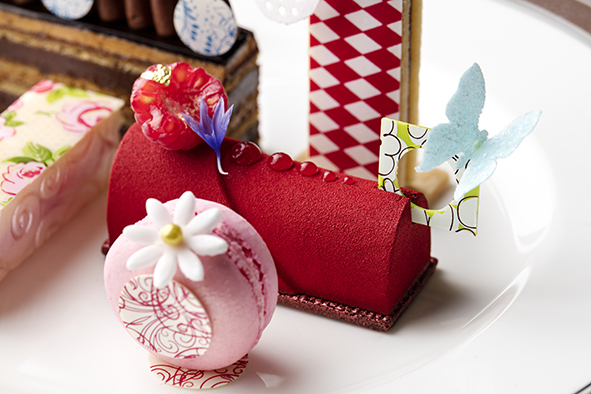
The Langham afternoon tea with Wedgwood (Photo: courtesy of The Langham)
The whole experience is not quite as tea-centric as one would expect afternoon tea to be. Much of the focus instead is afforded to the presentation and aesthetic element of the meal. Appearances seem to stand for a lot more in this environment. At least that feels like the case up until the scones arrive.
A scone is a classic British cake; it cannot be jazzed up too much, but it is quite easy to get wrong. Luckily the Palm Court scones are perfect. Fresh and fruity, with clotted cream and strawberry jam to rival anything one would find in the cream tea havens of Devon or Cornwall.
What ultimately makes our trip to The Langham worthwhile though is the gold-standard service; having my champagne and tea topped up amid rounds of exquisitely prepared and presented cakes is quite the experience. Perhaps the taste element could have been improved at times, but the theatre of afternoon tea presented here more than makes up for it.
The Langham presents the true tradition of afternoon tea, hardly changed over the years. But afterwards I feel eager to have a more modern tea related experience that is not bound by so much pomp and ceremony; something that focuses solely on the tea. I was certain that there was more to tea than a strong cup of PG Tips.
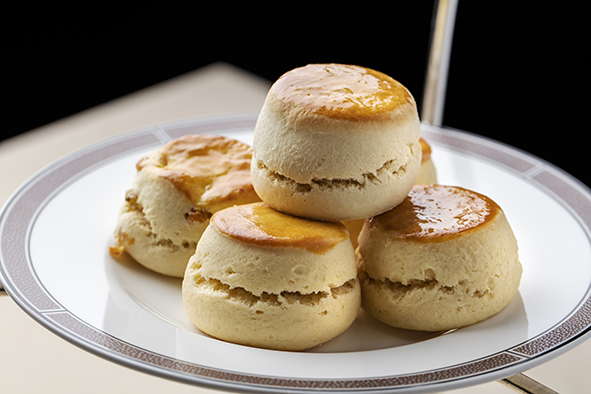
Scones at The Langham are perfect (Photo: courtesy of The Langham)
Medi-tea-tion
“Close your eyes if that helps. Take deep breaths in and out. When you drink the tea think about the taste and how it feels on your tongue. Is it silky or bitter? Is it easy to swallow the tea or do you need to gulp it?”
Soothing music plays in the background. I am in the apartment of Lera, a Lithuanian tea artisan who is introducing me to the art of tea meditation. I peek at the others sat around the table, seasoned spiritualists all. I feel like a complete phony shifting around trying to get comfortable, while struggling to find the kind of serenity that everybody currently oozes.
Truth be told, I had been sceptical about the whole thing. Tea is considered a British pastime, and I am typically British when it comes to drinking it: a cup of PG Tips thrice daily and, if I’m feeling a little dangerous, the occasional Earl Grey. However, tea aficionados might well brand this form of tea consumption in Britain an unrefined travesty: poor quality tea dusted into constricting teabags and tainted with lashings of milk.
“I think very few people really appreciate the complexity and variety of tea that exists in the world,” says Lera. Her knowledge and passion quickly win me around.
“Right, most people are maybe like me and just use teabags,” I say.
“Exactly, and with a teabag, the tea is trapped inside and cannot move around freely. You can really taste the difference drinking a brewed tea that was free to move around through all the water.”
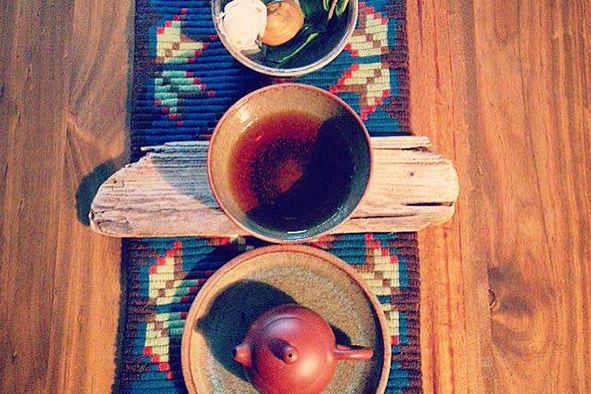
The focus is primarily on the tea (Photo: Lera Mimizu)
There are many kinds of tea: white, yellow, black and green; oolong, rooibos and matcha. The list is exhaustive. But real tea, loose leaf and fresh, is still not that common in Britain. Lera boils the kettle and talks about one of her favourite teas, pu-erh. Her movements in the preparation of the tea are nothing short of ceremonial. There is a deep spirituality to her process and I realise that tea is so much more than shoving a teabag into a mug with boiling water for her.
Pu-erh is a dark tea from the regions of Yunnan, the north of Vietnam and Laos, which boast one of the best climates for growing tea in the world. Pu-erh is a post-fermented tea; it has undergone a period of aging in the open air. Farmers age the tea for days, even years. The exposure to humidity and oxygen helps to oxidise the tea leaves and encourages fermentation. This changes the smell of the tea and also removes a lot of the bitterness from the taste.
“It sounds similar to the process of aging wine,” I say.
“The process is different but the effect of aging on the taste is certainly similar. But teas certainly have the variety that wine has.”
By now we are all sitting in ‘noble silence’. Lera pours boiling water into the clay teapot, allows it to brew for a moment then transfers the tea into a small bowl before me. She motions for me to drink. The silken tea has a deep, rich, earthy flavour. I have never tasted anything like it. The kettle brews and we repeat the process – good loose leaf tea can be brewed a number of times before losing its quality.
Something interesting begins to happen after the third bowl. The experience of only focusing on the present moment, of clearing the mind of all it’s noise pollution, is almost transcendental. I start to forget about how sitting cross legged is nothing but discomfort. I stop worrying about being an outsider, or about what the other people around the table are doing. I feel the stress and tribulations of manic London fall away. I feel relaxed in a way tea has never made me feel before.
After a number of bowls of tea later, during which the pu-erh never loses its strength or taste, the ceremony is over and the group rule of ‘noble silence’ is broken. I look at the Brazilian man with dreadlocks by my side as he starts to return to the room. He, along with everybody else, looks to be in a perfect state of relaxation and contentment. We chat a little about our experience afterwards over some nibbles, but I still cannot quite understand whether it was the tea, the meditation or a combination of both that had such a transformative impact.
It had taken a Lithuanian tea expert living in London to open my eyes to how good tea really can be. That is perhaps why tea is such a fine British pastime: British Imperialism brought tea to England, yet globalisation continues to help shape our experience of it. I’d like to think that the traditional afternoon tea and the modern tea ceremony, different as they may be, come from a similar urge – to satisfy the human need for social interaction over new experiences. I’ll happily raise a teacup to that.

Tea meditation (Photo: Lera Mimizu)
Further Information:
Palm Court is in the Langham Hotel (1C Portland Pl, Regent St, London). The Wedgewood Afternoon Tea is available with or without champagne. They have also teamed up with Hamleys to offer a Children’s Afternoon Tea.
Seatings are at 1:00pm, 3:15pm and 5:30pm
Lera runs t-lovers – which hosts a number of different events including tea meditations and tea tours across a variety of London locations. Tea meditations take place every Tuesday at 8pm, Thursday at 1pm and Sunday at 5am to catch the sunrise.
For a good overview of all the afternoon tea options available, check out afternoontea.co.uk
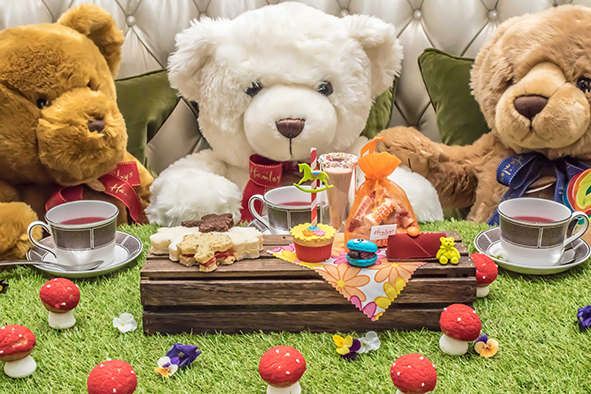
The Langham has teamed up with Hamleys to do an afternoon tea for kids (Photo: courtesy of The Langham)